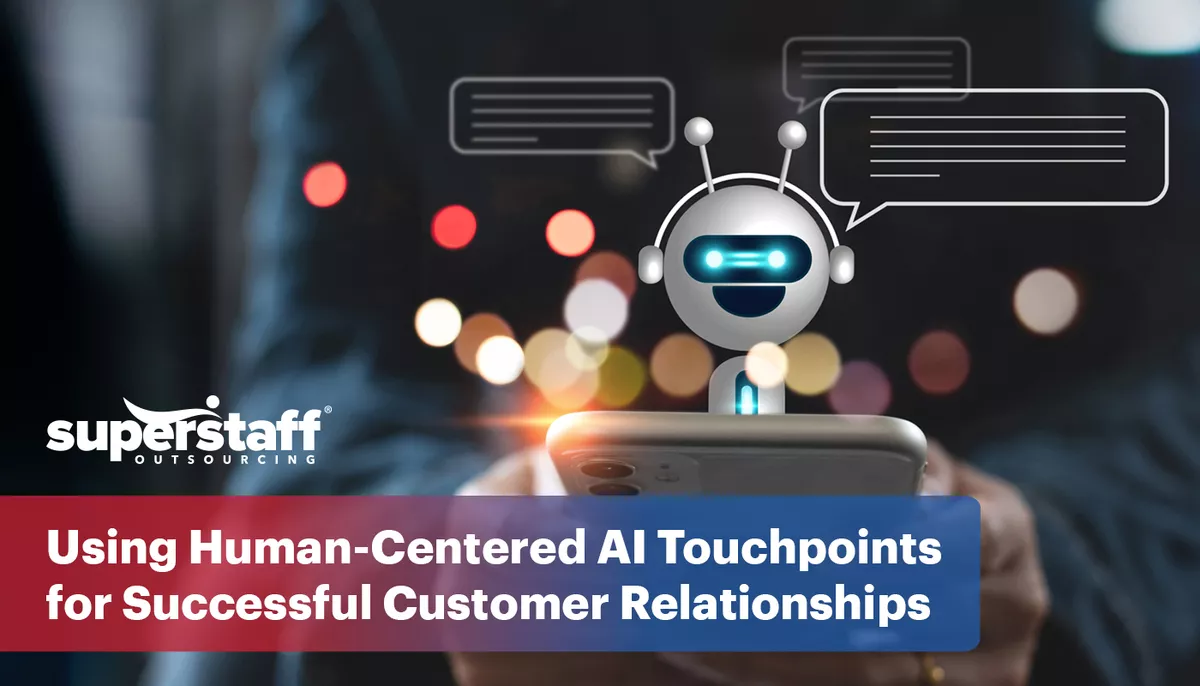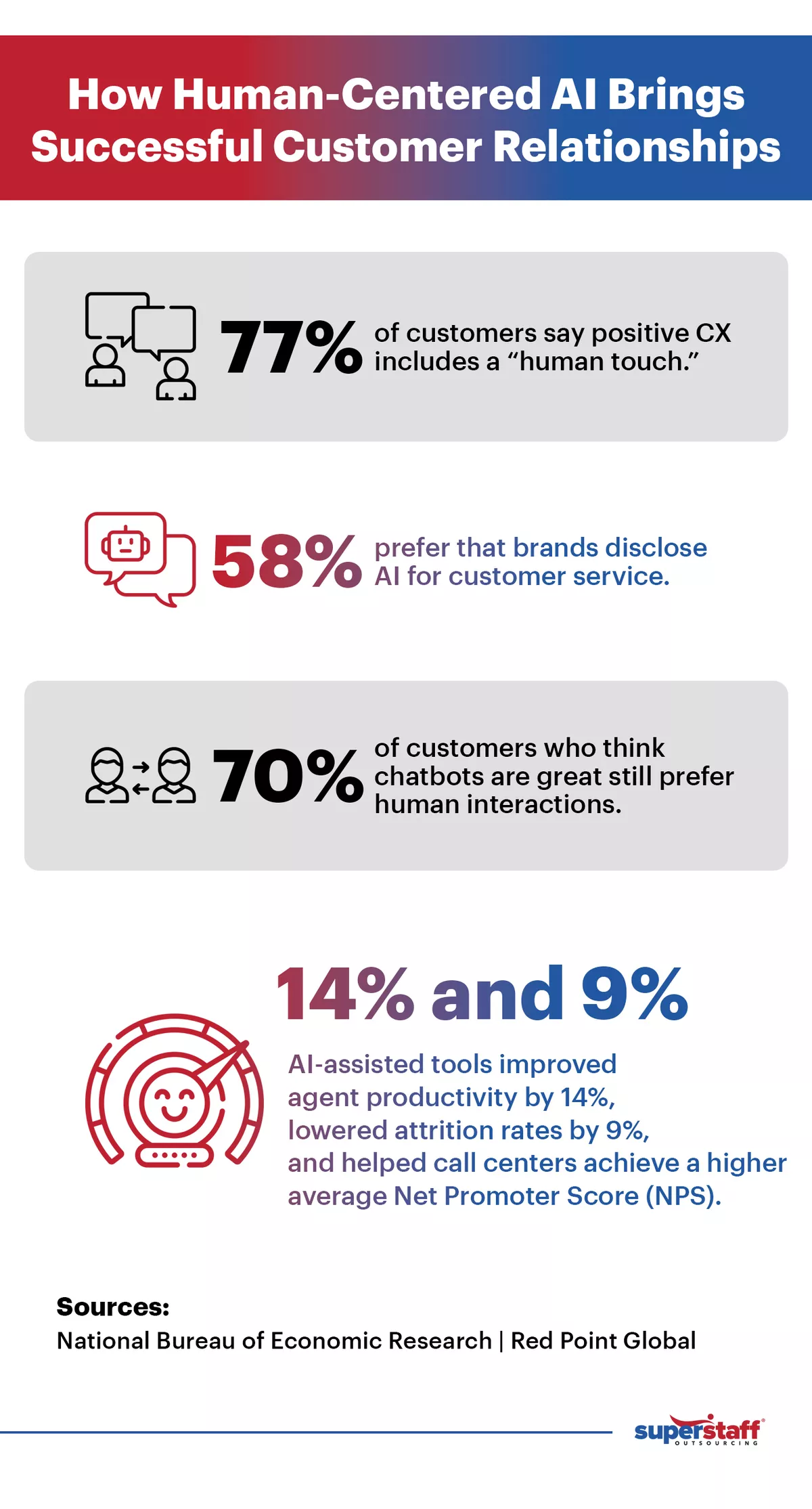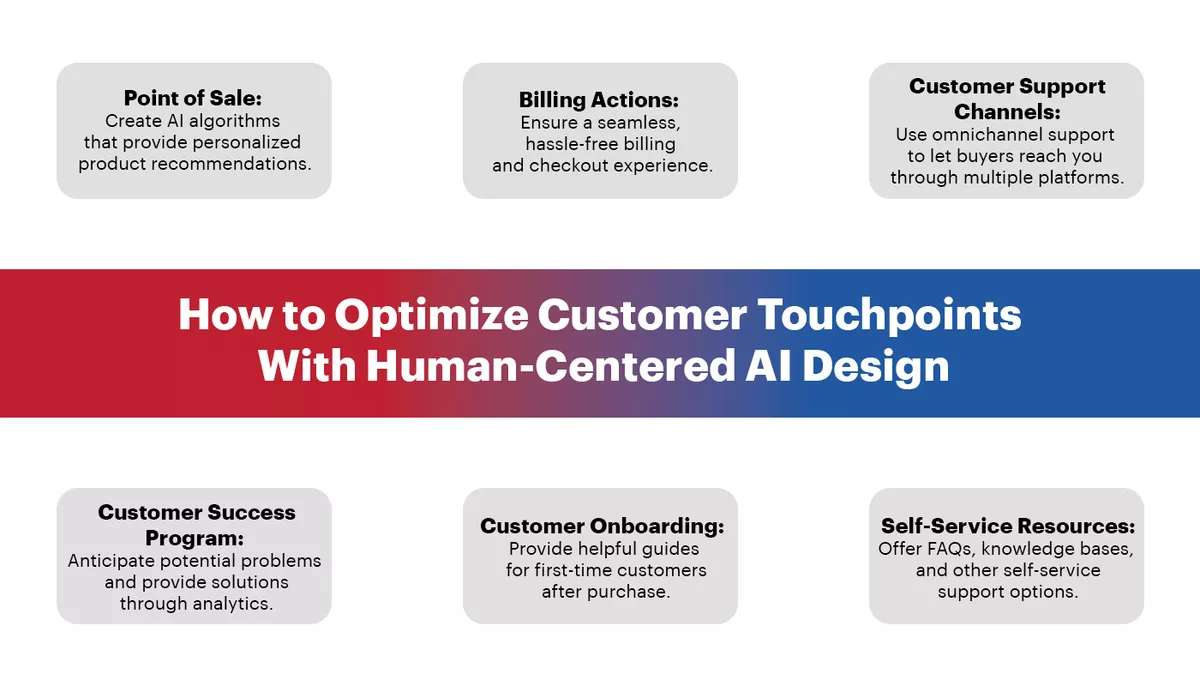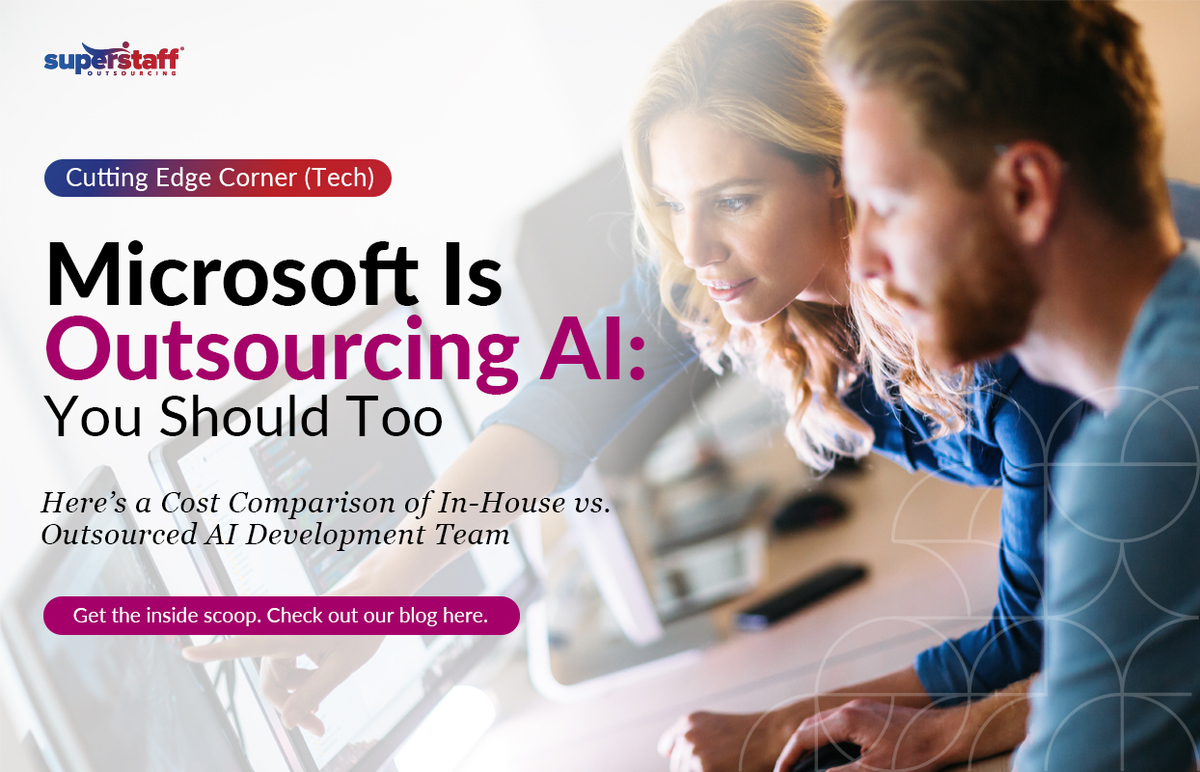
The emergence of artificial intelligence (AI) has taken the business world by storm. Today, more companies seek ways to integrate AI technologies into their operations, particularly for customer service.
Some business leaders may be tempted to use AI to replace traditional labor, but this move would be misguided. While AI tools are valuable for improving efficiency and reducing costs, human agents are still necessary for providing exceptional customer service.
According to a 2023 Redpoint Global study, 77% of customers say that a positive customer experience (CX) includes a “human touch,” and 58% prefer that brands disclose AI for customer service.
The ideal CX approach involves using artificial intelligence for greater productivity without neglecting the human touch that today’s consumers still crave. When crafting your customer experience strategy, focus on a human-centered AI design that helps you build stronger relationships with your buyers.

What Is Human-Centered AI?
Human-centered artificial intelligence refers to the concept of creating AI systems that support and amplify human capabilities instead of replacing them. Proponents of this emerging discipline believe that AI’s long-term success in business depends on preserving human control in its design and operation.
Applying Human-Centered Design to the Customer Experience
In customer service, incorporating a human-centered AI design helps your consumers feel that your brand sees them as individuals and cares about their well-being. In fact, the research mentioned above found that customers see chatbots as a great AI customer support tool, but 70% still prefer human interactions.
Meanwhile, another study suggests that supporting human agents is the ideal way to implement AI into customer service. Stanford and Massachusetts Institute of Technology researchers found that AI-assisted tools improved agent productivity by 14%, lowered attrition rates by 9%, and helped call centers achieve a higher average Net Promoter Score (NPS).
So, how can you create a CX strategy that integrates AI software into existing human customer service operations?
The key is to break down your customer touch points, assess which areas can benefit most from AI support, and work with your human CS team to innovate your processes.
Which Customer Touch Points Benefit From a Human-Centered AI Design?
Customer touch points include every interaction a buyer may have with your business, from discovering your brand to their after-sale experiences. Identifying and outlining your critical touch points on a map can allow you to more effectively strategize about which areas to optimize with AI software.
Let’s focus on the parts of your customer journey that will gain the most value from a human-centered AI design.
Point of Sale
The point of sale (POS) is the stage of a buyer’s journey when a customer is on the way to purchase. At this time, your sales representatives may make the case for why the consumer would want your products or services.
In traditional retail, stores optimize the POS stage by having designated staff members near the exits who can guide customers through their purchase decisions, promote new products and deals, and encourage impulse buying.
Meanwhile, POS systems for e-commerce use AI algorithms to connect buyers with relevant and personalized advertising messages.
For example, imagine that a customer is browsing your online store. Once they click on a particular product, your AI software will automatically send them recommendations (“people who bought this product also enjoyed…”) related to what they are about to buy.
Here’s a helpful strategy: Make sure your human service reps are available to communicate with customers through the live chat function of your website, assisting them while making purchases. Meanwhile, you can also utilize AI software that directs users to relevant products that may pique their interest.
Billing Actions
Billing is the customer touch point that happens during and immediately after a purchase. It is an often overlooked step in human-centered AI design because some businesses think CX ends after a customer buys something.
The truth is that billing is a critical part of the customer experience. Suppose a buyer has difficulty with any part of the billing process (for example, your e-commerce store offers limited payment options or doesn’t show prices in your customer’s local currency). In that case, they may abandon their carts, click away, and run to your competitor.
Ensure a smooth, hassle-free checkout process by harnessing AI technology. After purchase, follow up with your customers by sending an automated email thanking them and inquiring about their purchase experience. A dedicated email support representative should also be available to respond to any of their post-sale feedback and concerns.
Customer Support Channels
All platforms your customers use to communicate with your brand – phone, live chat, email, or social media – should incorporate a human-centered AI system. By outsourcing omnichannel support, you can ensure that all channels have dedicated support agents available 24/7 to respond to inquiries and resolve customer issues.
At the same time, AI-powered chatbots can help reduce the workload of your human CS team by providing quick answers to frequently asked client questions and minimizing wait times for live chat support.
Customer Success Program
The customer success program is another commonly overlooked touch point in the buyer’s journey. HubSpot’s research found that 70% of businesses with growing revenue viewed these initiatives as essential to their CX strategy.
In today’s increasingly competitive CX landscape, simply waiting for consumers to reach out to your support channels is insufficient. Businesses must now be proactive in providing customer service.
A dedicated customer success team anticipates potential problems by analyzing available client data and then reaches out with solutions. Meanwhile, AI software can automate specific customer success initiatives, such as, for example, sending email or app notifications when unexpected order delays or cancellations occur.
Customer Onboarding
Customer onboarding means assisting new clients post-purchase, primarily guiding them through using your product or service. The onboarding process makes it easier for customers to understand their purchased products and helps your brand establish trust and build relationships with them.
To optimize this part of the buyer journey, ensure you have a dedicated onboarding specialist ready to welcome customers, guide them through the process, and answer their questions along the way. You can use AI systems to send automated emails that connect your customers with your onboarding team and help them schedule virtual calls and training.
Self-Service Resources
Sometimes, customers may be in a hurry to find answers or prefer to resolve problems independently. In these cases, offering self-service resources, such as knowledge bases or FAQs, may be the ideal solution.
Contact centers often record and document all customer interactions. The outsourced CS professionals can then use artificial intelligence tools to help them organize their data and compile the most frequent customer questions and complaints to create self-service customer support resources.
Human-Centered AI Examples Across Different Industries
Retail
Retailers worldwide are discovering the immense potential of using AI to support the customer experience. One example is the real-life success case of retail giant American Eagle.
To help customers imagine how they would look in American Eagle apparel, the retailer partnered with Aila Technologies to integrate AI software into their fitting process.
Now, they have in-store interactive dressing rooms that use computer vision and machine learning (ML) technologies to scan customer body measurements and provide style suggestions and sizes.
Technology
Beyond retail, CX is also essential for businesses that offer digital products, such as the video game industry. Krafton, a South Korean video game development company, is one example of a brand that used AI to enhance customer service operations.
By partnering with Zendesk, Krafton utilized AI software for more effective customer service and technical support ticket management. Their collaboration was an astounding success, resulting in a 15% support cost reduction, minimizing ticket processing time by 18%, and adding 13 languages for multilingual support.
Media and Entertainment
Here’s an example you may be familiar with: Netflix, the popular streaming service, uses AI and ML technology to create personalized user experiences for its large customer base.
The Netflix algorithm analyzes each customer’s behavior, noting viewing history and preferences to provide relevant content recommendations and advertising messages.
Beyond customizing UX on the app, Netflix also uses AI to streamline the production of their original movies and shows, utilizing cutting-edge technologies to keep them at the forefront of the streaming and entertainment industry.
E-Commerce
Artificial intelligence has revolutionized the e-commerce industry, as is the case with Amazon, one of the world’s most renowned multinational corporations. Like Netflix, the e-commerce giant uses AI and ML software to collect customer data (particularly users’ buying habits) and provide recommendations predicting which products may interest the customer.
In addition to its recommendation system, Amazon uses predictive analytics to enable “anticipatory shipping.” It is a process where they send out predicted high-demand items (based on AI forecasting) to their shipping hubs, helping to cut down on order fulfillment times and ensure seamless deliveries.
Banking and Finance
Financial service institutions are also beginning to tap into the potential use of AI for banking assistance.
According to the Consumer Financial Protection Bureau, 4 out of 10 Americans knowingly or unknowingly interacted with a banking chatbot last year. Industry experts predict this number will continue growing in 2023 and beyond.
The Bank of America, for instance, uses an AI chatbot called “Erica” to handle hundreds of millions of customer service requests and inquiries each year. HSBC also has a dedicated chatbot named “Amy,” while Capital One has “Eno.”
Logistics
Another industry harnessing the power of AI for customer experience is the transportation and logistics sector. A McKinsey study found that using artificial intelligence tools has helped the industry improve logistics costs (15%), inventory levels (35%), and service levels (65%).
Adopting AI solutions allows logistics companies to facilitate real-time visibility into every aspect of their supply chain, including end-to-end transparency and effective demand forecasting.
Creating a comprehensive, data-driven CX strategy becomes easier as supply chains become more efficient. Transportation and logistics companies can now prioritize same-day and on-time deliveries, minimizing waiting times and enhancing customer satisfaction.
Embrace human-centered AI for business. Let SuperStaff help you craft your reinvented CX strategy.
As we enter the Age of Artificial Intelligence, providing exceptional human-centered customer experiences must still be a top priority for businesses of all industries.
Here at SuperStaff, we’re dedicated to helping you do just that. Blending innovation with human customer service excellence, our comprehensive BPO solutions can empower your brand as you navigate this challenging transition period.
Don’t be afraid to modernize and transform your customer experience. With our team of outsourced professionals, you can craft a human-centered AI design plan that works for your specific business needs.
Connect with us today, and let’s discuss how we can support your CX strategy!







